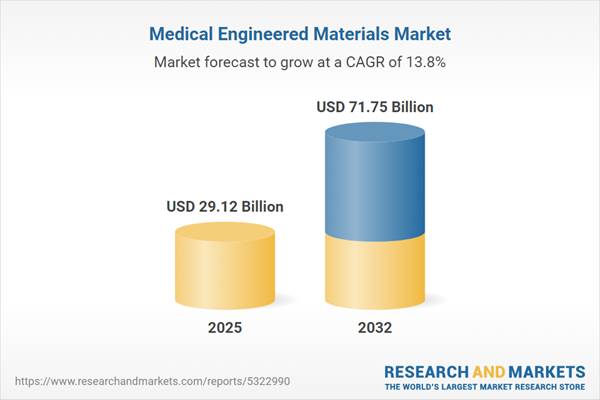Speak directly to the analyst to clarify any post sales queries you may have.
The medical engineered materials market is evolving swiftly as healthcare organizations turn to advanced materials to improve patient outcomes, drive efficiency, and address increasing operational challenges. These engineered solutions are shaping new benchmarks in healthcare manufacturing and providing decision-makers with critical pathways for innovation and value creation.
Market Snapshot: Medical Engineered Materials Market Size and Growth
The global medical engineered materials market is currently valued at USD 25.59 billion, with a projected expansion to USD 29.12 billion in the coming year, and a forecast to reach USD 71.75 billion by 2032. This growth corresponds to a compound annual growth rate of 13.75%. Intensifying technology innovation, the pursuit of resilient supply chains, and sector-wide investment in manufacturing capabilities are primary drivers enabling organizations to maintain agility, meet regulatory requirements, and capitalize on growth opportunities in a dynamically shifting landscape.
Scope & Segmentation of the Medical Engineered Materials Market
- Material Types: Ceramics such as alumina and bioactive glass offer durability and biocompatibility, which support the production of reliable implants. Advanced composites blend metallic, ceramic, and polymer properties for specialized device performance. Biocompatible metals like titanium and stainless steel are used for robust, long-lasting medical tools and implants. Polymers including PMMA, PTFE, polyethylene, polyurethane, and silicone introduce flexibility and adaptability, helping products suit a wide range of medical needs.
- Applications: Key uses include cardiovascular devices, dental prosthetics, and surgical implants engineered to focus on reliability and precision. Nanoparticles empower targeted drug delivery systems, while next-generation polymers advance eye care and therapeutic solutions. Bioprinting technologies are enhancing orthopedic solutions and expanding the possibilities for regenerative and personalized medicine.
- Manufacturing Processes: Additive manufacturing, including electron beam melting and laser sintering, enables custom, patient-specific device creation. Traditional processes such as extrusion, injection molding, and CNC machining support scalable production while upholding industry quality standards.
- End Uses: Diagnostic equipment, implantable devices, dental products, and surgical instruments form the backbone of sector demand, supporting efficient workflows in clinical settings like digital monitoring, infusion, and cardiac care solutions.
- Regional Coverage: The Americas retain leadership in adoption and innovation, driven by increased investment and technological development. EMEA navigates diverse regulatory frameworks, requiring varied market entry and growth strategies. Asia-Pacific invests in public health initiatives and demonstrates robust demand for enhanced medical solutions, reflecting both economic development and healthcare modernization.
- Key Companies: Industry influencers—including Evonik Industries AG, Covestro AG, Royal DSM N.V., BASF SE, Lonza Group AG, Merck KGaA, Celanese Corporation, Solvay S.A., Arkema S.A., and Wacker Chemie AG—guide technological progress and strategic investment across the sector.
Key Takeaways: Strategic Insights in the Medical Engineered Materials Sector
- Modern manufacturing and coating advancements support tailored device solutions, elevating both clinical outcomes and compatibility with patient needs.
- Stronger regulatory insight and deliberate material choices equip organizations to foster continuous innovation and ensure regulatory compliance throughout product lifecycles.
- Flexible device architecture promotes operational efficiency, rapid market entry, and enhanced teamwork among technical, production, and commercial divisions.
- Transferred technologies from adjacent sectors speed up the adoption of novel medical components and devices, broadening the landscape for rapid advancement.
- Sustainable procurement practices and robust supply chain frameworks underpin uninterrupted operations, while advancing sustainability and compliance with evolving standards.
Tariff Impact: Navigating U.S. Trade Dynamics in 2025
Recent U.S. tariff adjustments on imported medical engineered materials have prompted organizations to expand supplier relationships and pursue near-shoring solutions. This proactive stance strengthens risk mitigation, secures supply continuity, and sustains environmental and regulatory commitments within a changing North American marketplace.
Methodology & Data Sources
This examination synthesizes primary interviews with industry leaders, comprehensive reviews of sector and regulatory databases, scenario analysis, and cost benchmarks. The chosen methodology is tailored to deliver actionable, sector-aligned guidance for senior executives responding to evolving market conditions and emerging opportunities.
Why This Report Matters for Senior Decision-Makers
- Facilitates timely assessment of evolving regulatory and market conditions, supporting effective executive planning and strategic risk management.
- Enhances operational preparation and supply resilience, enabling organizations to navigate shifts in global healthcare and technology environments.
- Offers clear insight into technological innovations, new partnerships, and competitive shifts to drive informed business decisions and sustained growth.
Conclusion
Senior decision-makers receive the critical intelligence needed to shape direction, ensure compliance, and maintain competitive value as advanced materials redefine the healthcare sector globally.
Additional Product Information:
- Purchase of this report includes 1 year online access with quarterly updates.
- This report can be updated on request. Please contact our Customer Experience team using the Ask a Question widget on our website.
Table of Contents
3. Executive Summary
4. Market Overview
7. Cumulative Impact of Artificial Intelligence 2025
Companies Mentioned
The companies profiled in this Medical Engineered Materials market report include:- Evonik Industries AG
- Covestro AG
- Royal DSM N.V.
- BASF SE
- Lonza Group AG
- Merck KGaA
- Celanese Corporation
- Solvay S.A.
- Arkema S.A.
- Wacker Chemie AG
Table Information
| Report Attribute | Details |
|---|---|
| No. of Pages | 183 |
| Published | November 2025 |
| Forecast Period | 2025 - 2032 |
| Estimated Market Value ( USD | $ 29.12 Billion |
| Forecasted Market Value ( USD | $ 71.75 Billion |
| Compound Annual Growth Rate | 13.7% |
| Regions Covered | Global |
| No. of Companies Mentioned | 11 |









